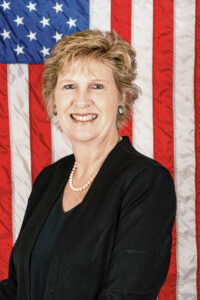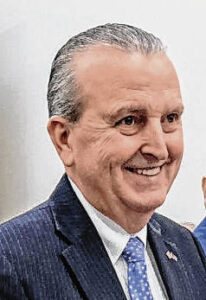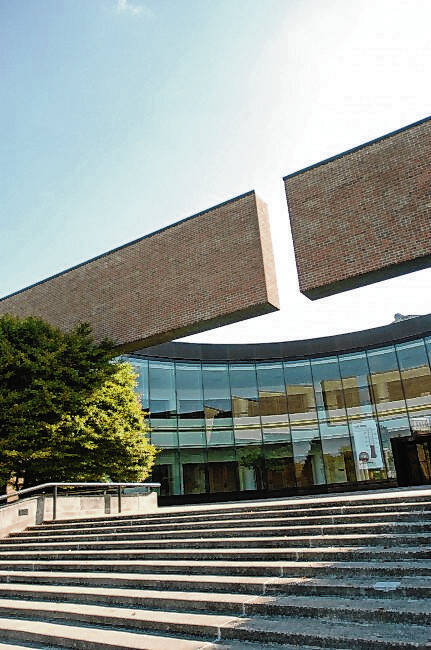A former Indiana state representative and current high-ranking Columbus city official are seeking the Republican nomination for Columbus mayor in the May 2 primary.
This year, there is no incumbent on the ballot, as current Columbus Mayor Jim Lienhoop previously announced that he will not seek another term in office.
Mary Ferdon, 61, the city’s executive director of administration and community development, and Milo Smith, 72, former Indiana State Representative for District 59, have both thrown their hats into the ring for the GOP nomination.
 Mary Ferdon
Mary Ferdon
 Milo Smith
Milo Smith
Milo Smith
Q: What would be your specific priorities if elected mayor of Columbus?
Ferdon: Throughout my life in public service, I’ve learned that people value living in a safe place with quality public services, good jobs that provide for their families, high quality medical care, excellent education for their kids, and opportunities to achieve their version of success.
In the past seven years I’ve worked to make Columbus a city that meets or exceeds these expectations. As mayor, my priorities will be: quality public services with a focus on safety, a vibrant economy where good paying jobs are available and businesses share our tax burden and a community where people choose to live and work.
Quality public services like good roads, safe drinking water, efficient trash pickup and well-maintained parks are important, but public safety is always job one. I will continue to put resources into hiring and training competent police officers and firefighters, as well as investing in critical equipment and the training necessary to do their jobs excellently. We’ve had success with an intelligence-led policing emphasis and partnerships with other law enforcement agencies. I will continue to support these efforts. This approach resulted in a 41% decrease in property crime since 2016.
I place high priority on our work with ASAP to reduce the heartache and burden of substance use disorder on individuals, families and city and social services. I strongly support the successful programs already in place. My work with the newly created mental health alliance is focused on solutions to deal with the challenges that affect our schools, workplaces and families.
Our city competes directly with communities near and far for talent and good jobs. We see this more than ever in this post-pandemic era. In the past seven years we’ve been able to attract new business and expansions, create job opportunities, reduce homeowner tax rates and fund our schools and civic services. The city’s tax rate has reduced from $1.13 to $1.09 per $100 of assessed value over the past 10 years.
I will work to continue to ease the burden on our taxpayers. Diversification beyond auto manufacturing remains a focus of mine, as does continuing the city’s support of workforce development funding. I will also update the city’s transit system to provide more flexible and responsive transportation solutions.
Less visible post-pandemic is the choice of many to work remotely. We need amenities which appeal to both current and future residents, families, and seniors so they choose to both live and work here.
A priority is the continued development of NexusPark, a community center focused on health, wellness, recreation, and economic development. I will work with partners at the new downtown development office to support a vibrant downtown – which includes the planned hotel conference center, an urban grocery, more dining and retail and additional housing.
I am particularly excited by our new gig speed internet project. This provides both business and residential benefits.
Lastly, I will champion a Housing Development Board to address our city’s need for affordable, accessible, and dignified housing.
Smith: To protect the life of all residents of Columbus, I will appoint a Director of Public Safety that possesses a wide range of strategies to ensure public safety by overseeing all public safety services delivered and expected by our community. This director will:
- Determine the root causes of public safety threats. If there is a spike in any type of crime this director will investigate why and then take action to minimize this spike
- Monitor the use of public safety resources, which may need to be increased when Nexus Park starts hosting anticipated large events attended by people from outside of Columbus. Large outside crowds will probably increase the demands on our city police, city fire and EMTs. We must prepare in advance so that we don’t strain the city’s ability to respond to other situations or emergencies that will probably present themselves.
- Participate in a collaborative approach to eliminating illegal drugs in our community.
- Update emergency preparedness and response plans that ensure Columbus can handle emergencies such as civil unrest, public health crises, natural disasters, chemical spills.
I will prioritize spending taxpayers’ dollars wisely and I will encourage all Tax Increment Financing Districts (TIFs) to use their cash balances held in surplus which will lower property tax bills for Columbus residents.
Q: The Columbus Riverfront Project is probably one of the most controversial and longest running projects during the Lienhoop administration. What is your take on the improvements of the riverfront?
Ferdon: Providing safety and removing physical hazards must be a priority for any city. The safety issues along the White River date back several decades and are long overdue to be fixed, before something regrettable and preventable happens. These, include a failing low head dam, a Superfund toxic waste site, an exposed 100-year-old sanitary sewer line, bank erosion underneath the pump house and a dangerous People Trail crossing over State Road 46 – the intersection which has the highest number of pedestrian and vehicle accidents in the city.
Low head dams can be deceivingly dangerous, so much so that the Indiana DNR has recommended their removal throughout the state. Statistics show in Indiana between 2010 and 2020, 25 people have died and another 17 others have been injured because of the circulating currents they cause, which pull people underwater.
Second, a former landfill located on the south side of the White River is a de-classified EPA Superfund site which is currently at risk of exposure due to scouring by the broken pieces of the dam. If it is not properly sealed, we will eventually have toxic waste flowing into the river. There is also erosion along the east riverbank which has exposed a sewer line along the river and contributes to tree fall dams during high water events.
And lastly, the People Trail crossing from Mill Race Park to the eastern side of Third Street is the most dangerous crossing along our trail system. It needs to be re-routed for safety and ease of movement under the Second and Third Street bridges, as we have many families with young children using that section of the trail. My husband and I use the People Trail frequently and this area is an impediment to getting from Mill Race Park to the greater downtown area. The impetus of the riverfront project is to address all those safety concerns.
Recreation in the river was never the starting point for the project but was recommended as a potential amenity that could be added as part of the in-water work required for the dam removal and bank stabilization. The in-water recreation component was brought forth through community surveys where the overwhelming response from the participants was to activate use of the river, with most interest in a kayaking component. These improvements would make the river 100% ecologically healthier than it is today, with the potential to drive tourism and promote visitors spending their dollars here.
As most are aware, this project has made little progress, due to a burdensome permitting process required for any river front development. I believe the Columbus Redevelopment Commission has exercised due diligence in engaging expertise throughout the project to do it correctly and encompass the desires of residents.
Bottom line, although this project has been slow with many complicating factors, we need to take care of the safety and the health of the White River. My intent is to be a responsible steward now and not push problems to future generations.
Smith: Knowing that the Riverfront project was developed based upon considerable community input I too believe we should have a lighted trail on the east bank of the river connecting to other pathways in the vicinity, if it is constructed with low maintenance materials that will withstand flooding. I believe we need to make certain that removing the low head dam will not alter the amount of water held in lakes at The Lagoons before it is removed. The old dump area on the west bank of the river needs to be cleaned up to protect our environment while being fiscally responsible.
Q: Many households in Columbus are feeling the strain of housing costs, and there is a shortage of affordable housing units in the city. What would your approach be to expanding the city’s supply of affordable housing?
Ferdon: The lack of affordable housing, across a wide spectrum of income levels, has been a long-standing issue across the country, with no easy and obvious solutions. Material and labor shortages driven by the pandemic made a bad situation worse. The city’s efforts to address this issue over the last seven years has met with some success and we are pleased that one out of every three apartment units built in Columbus has been classified “affordable.”
Although on a much smaller scale, my office has collaborated with the Lincoln Central Neighborhood, Heritage Fund, several other entities, and the Bartholomew Consolidated Schools, to enable their construction trades class students to add one house to the neighborhood each year for the last four years. These affordable homes have been sold to first time homebuyers who have successfully transitioned from tenancy to homeownership.
An issue that is also negatively affecting the Columbus housing market is the increasing number of homes in Columbus that are being purchased by out-of-state investors, who then rent them out as absentee landlords. Many are offering cash and are driving the price of housing higher. Although the rise in sale prices has been beneficial for sellers, it has a negative effect on the affordability of local rental housing.
Absentee landlords as a rule do not put as much care into maintaining their property as local owners. When residents purchase houses to rent out as a source of income, they have a vested interest in the community and thus do a better job of maintaining the homes and are better able to work with residents who are experiencing hardship. As much as we would like to keep homeowners local, city government doesn’t have the ability or right to prevent contracts between individuals concerning the transfer of real estate. We can, however, respond to complaints from tenants who have challenges with absentee landlords, and I will continue to equip the Code Enforcement Office with the tools needed to help these tenants.
Housing is one of the biggest challenges cities face because unfortunately, single and multifamily housing cannot be built as quickly as demand warrants, nor can it be built without some up-front capital. In addition, developable parcels within city boundaries are scarce. Cities have a few tools we can continue to use such as tax supports to affordable housing developers and city support of tax credits awarded through the state. I will encourage the city council to use those tools whenever possible and appropriate.
If elected, my priority on this issue will be to create a Housing Development Board. Its mission will be to identify specific local gaps, benchmark what other cities have done well, and not so well, in response to these gaps, and then develop strategies and recommendations to close Columbus’ gaps. The board will represent a broad spectrum of those involved in the housing world – developer, Realtor, landlord, the city, tenants, and representatives from housing agencies.
Smith: I would encourage private investors to construct affordable housing units knowing that the city would consider long-term tax abatements if they discounted the monthly rents substantially below current market rents for residents living in poverty.





